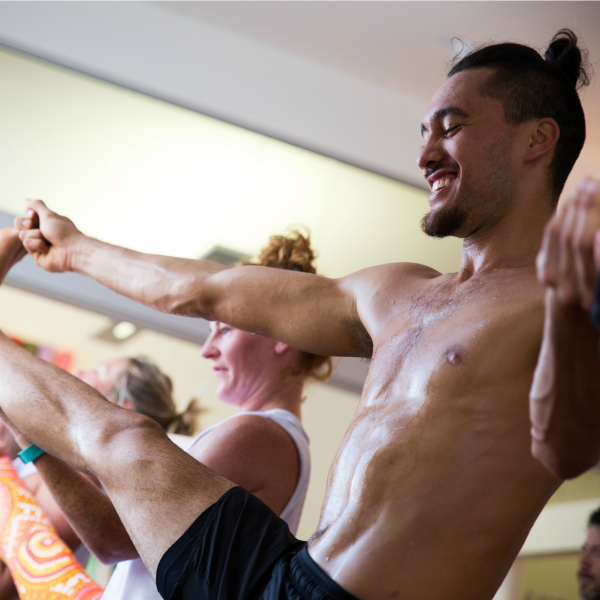15 Jun You Need To Know These Popular Sanskrit Words, Yogis.

Whether you’re a seasoned yogi or have just found the practice over the last weeks, we understand that sometimes it seems like yoga can be a bit alien. Sometimes it seems your yoga teacher speaks a foreign language. And even though you might have heard these “yogi words” or expressions so many times, sometimes it can still be a mystery to what these interesting-sounding words mean. We have handpicked some common yoga Sanskrit words which you might hear in class, so you get to know them (and, in turn, the practice) better.
Firstly, Sanskrit might sound foreign to you. Quite rightly so, because…well, it is. Sanskrit was considered the language of the Gods, and this over-3,000-year-old ancient language was the conventional spoken and written word during the time yoga was developing in India. The ancient collections of hymns, literature, philosophy and texts are all in Sanskrit. For example, the Bhagavad Gita and Patanjali’s Yoga Sutras were passed on orally in Sanskrit for centuries before they were written down.
We’ll not dive deep into the full world of Sanskrit below – it’s a lifelong study if you’re that way inclined. This post is just a quick overview of some of the most commonly used words in yoga classes. Let’s brush up on your Sanskrit, so you are in the know the next time you roll out your mat in your favourite yoga studio or the comfort of your home.
Yoga.
Before we dive in, let’s start with the word yoga first. When we think of yoga, we usually just think of the physical poses, asanas, we contort ourselves into on our mats. Yoga is so much more – something you typically find out once you allow yourself to dive deeper into the practice.
Yoga is the union of body, mind, and spirit. And the word yoga means ‘to yoke’ or ‘union’. And it’s true when we roll out our mats we are practising connecting our body, mind, and spirit. But the practice is so much more; it’s about connecting us to ourselves, each other, our environment, and, eventually, our truth.
Aum.
Also, more known as ooooohhhmmmm – the sound we chant at the opening or end of a yoga class. The sound of the universe. The hum of the earth. What that means is that we are all part of this universe – we are always moving, changing, evolving and breathing. AUM represents the past, the present and the future. When we chant AUM, we’re tapping into the vibration of the universe. It’s very powerful, and you can feel it throughout your whole being. You might have also experienced the ripple effect of this vibration in a packed class. It’s magical.
Shanti.
You might have heard or chanted Shanti following your aum chant at the end of your class. Shanti means peace. So, when we sing, “Om Shanti Shanti Shanti,” it’s an invocation of peace. We chant it three times as, in Buddhist and Hindu traditions, we invoke peace in body, speech, and mind.
Ujjayi breath.
You’ll probably come across this word in the first few moments of your class. Teachers usually say something like you “if it’s in your practice, come to your ujjayi breath now”. Commonly also referred to as the oceanic breath. Ujjayi breath is widely translated as “victorious breath,” and should be energizing and relaxing. It has been used for thousands of years to enhance hatha yoga practice.
The sound of Ujjayi is created by gently constricting the opening of your throat, creating a little resistance to airflow. The sound you create with your inhale and exhale resembles the soothing sound of ocean waves, which helps us synchronize your breath with your movements on the mat.
Asana.
In a nutshell, asana refers to the physical aspect of our yoga practice and what we commonly associate with yoga. Despite that, asanas are only one aspect of the eight-limb practice outlined in Patanjali’s Yoga Sutra. The Sanskrit word ‘asana’ comes from the root ‘asi’, which means, ‘to sit or to be’. Literally, the word asana means ‘a state of being’, which you initially can only achieve while in a seated position. Modern yoga defines asana as a yoga posture.
In class, you will hear the word “asana” a lot. Every yoga posture in Sanskrit ends with “-asana”. For example, Downward Facing Dog is called Adho Mukha Savanasana in Sanskrit. Once you break it down, it means just that: Adho: downward Mukha: face Svana: dog Asana: pose.
Drishti.
Your yoga teacher might remind you to focus on your Drishti instead of letting your eyes wander to draw your into ‘compar-itis’ with how someone else is doing in the pose or the fancy yoga tights of the yogis behind you while you are in your first Downward Facing Dog. For example, when you are in Warrior Two, the drishti is focusing your gaze out in the distance over your front middle finger.
Drishti is the cherry on top of your yoga pose if you wish to call it that. After you focus on your physical posture and your breath, it’s the drishti that locks in the pose, improving your balance, calming your mind and locking you into the present moment. You are focusing your gaze on one thing. For example, when you are in Warrior Two, the drishti is focusing your gaze out in the distance over your front middle finger. Drishti doesn’t mean intently eyeballing the wall or yogi in front of you. Try to look gently down the tip of your nose to a point on the floor. Or a wall in front of you. Relax your eyes so that the surrounding area also comes into your awareness. Give it a go next time you feel distracted or are a bit too shaky in your tree pose.
Mudra.
Mudras are sacred hand gestures and seals that have around for thousands of years in many different traditions as a way of deepening your practice and awakening the power of the Divine. There are so many mudras for almost every yoga pose. Most commonly known and used in seated meditation is probably Gyan Mudra. The tip of the thumb and index finger lightly touch, while the remaining three fingers remain outstretched.
Every mudra has a particular purpose and moves prana (energy) in a specific way throughout the body to create subtle physical, emotional and mental changes. For example, before you begin a seated meditation practice, if you feel anxious, your teacher might give you the option to place the palms of your hands down on your thighs to ground and calm your energy. Or palms facing up when you feel down, sluggish and need some uplifting energy.
As already mentioned in the beginning, the above is just an overview. These are just some of the most common Sanskrit words you might hear in your yoga class. It is just the tip of the iceberg, as there is so much more to explore and learn when it comes to Sanskirt. Although Sanskrit might seem confusing at first, it is such a beautiful language once you get to know it more. It will slowly transform your practice the more you know about it and understand the meaning behind the original language of yoga.
And do you know what the best part is? Because a lot of yoga teachers globally use Sanskrit in their classes to name the asana poses, you can practise yoga anywhere in the world without speaking the local language. You can still follow a class by just listening. We, yogis, around the globe, are all connected through Sanskrit reminding us again what yoga is all about: Union.
If you want to know more details about this, you might want to head over to Yoga Journal for a deeper dive into all things Sanskrit.
See you on the mat, yogis!
Written by Bettina Simbuerger



